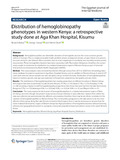| dc.description.abstract | Background
Hemoglobinopathies are inheritable disorders of hemoglobin and are the most common genetic defects in humans. This is a neglected public health problem whose undiagnosis remain a major threat to its prevention and control in sub-Saharan Africa countries; thus its exact magnitude on morbidity and mortality remains poorly documented. These hemoglobin disorders have been associated with Plasmodium falciparum; therefore, the current study sought to determine its distribution in a malaria-holoendemic region of Western Kenya as part of remedial intervention recommended by World Health Organization (WHO).
Method
This study analyzed data conveniently selected through census from 2015 to 2020 from hematology laboratory database for patients examined in Aga Khan, Hospital, Kisumu, and its satellites in Western Kenya. A total of 247 cases were selected whose sample size was calculated using Cochran’s formula. Distribution of hemoglobinopathies based on stations, gender, and age was expressed in frequencies, proportions, bar graphs, and pie charts.
Results
The distribution of hemoglobinopathies had varying proportions in different locations in Western Kenya with regions that were at proximity to Lake Victoria (Kisumu 41.3%, n = 102; Busia 21.5%, n = 53; Homabay 15.4%, n = 38) recording a higher overall hemoglobinopathy proportions than those that were far from the lake that include Bungoma 5.7%, n = 14; Kakamega 4.0%, n = 10; Kitale 4.0%, n = 10; Kisii 4.0%, n = 10, and Migori 4.0% n = 10.
Conclusion
The study represents the burden of hemoglobinopathies in a malaria-holoendemic region of Western Kenya, and even though the present study did not include ethnicity in data collection, stations from where the data was collected are predominated by different communities; therefore, there may be an ethnic correlation in the variation of hemoglobinopathies in Western Kenya. The communities juxtaposed to the lake seems to be the most affected ethnic group along the Lake Victoria economic block region; thus, it may be erroneous to assume that the entire malaria-holoendemic region of Western Kenya has high prevalence of hemoglobin disorders without factoring ethnicity and geographical location in a properly conducted population-based prevalence study in the wider Western Kenya. | en_US |

